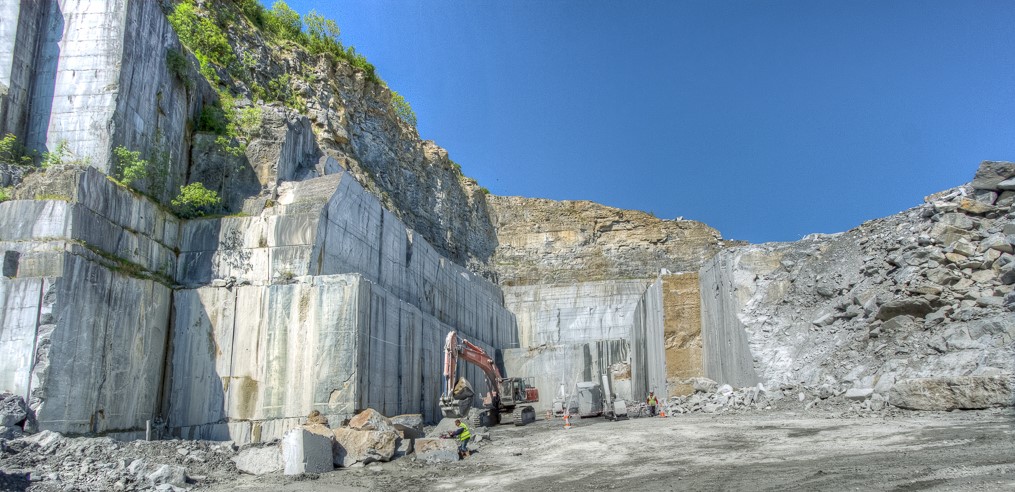
Extraction
Day to day extraction of the limestone is planned by skilfully combining exploration drilling results, daily monitoring of the exposed stone in the quarry and the feed back from the sophisticated quality control in the production area.
Cores recovered from the future reserves provide the basic production information on colour, texture and fracture zones to assure the long-term capabilities of the industry.
High Technology
High technology diamond wire saws, diamond tipped chainsaws or circular diamond cutting blades, slice the massive beds in the quarry into blocks sized to the processing plants.
Cooling water, recycled through settlement ponds on the quarry floor, prevent the diamonds overheating and suppresses the dust produced by the cutting equipment. Careful positioning of the narrow slots produced by the diamond cutters yield optimum sized blocks for processing with the minimum of waste during extraction.
Like all natural materials there are flaws and fractures within the stone which make it imperative that this material is excluded from the processing plant. Skilled quarry workers using pneumatic or more hydraulic breakers, enable these variations in production requirements to be easily and effectively accommodated.
Traceability
Transporting the blocks to the processing plant in a safe and efficient manner is equally important. Carefully positioned haul roads and modern loaders equipped with handling forks mean that an eighteen to twenty tonne block of stone can be picked up from workings without hazarding the quarry workers and minutes later be deposited undamaged in the stock yard of the processing plant. Every block leaving the quarry has a unique identification code enabling any piece of limestone supplied for a building to be traced by to its point of origin in the quarry.
Overburden from the quarry development is used to restore worked out areas or completed quarry tips. Waste limestone, which is an unavoidable by-product of the quarrying and processing, is crushed to provide aggregate for the construction industry when viable. Where there is no economic alternative the waste is used to construct screening banks or placed into designed tips that will ultimately be restored to blend into the surrounding landscape.
Production / Processing
A travelling crane will normally pick up the blocks from the stock yard and position them on a frame saw, mono-blade saw, diamond wire saw or circular saw depending on the final product. Diamond technology minimises cutting waste and ensures the accuracy of the cut limestone.
Sophisticated flocculation plants or settlement lagoon systems clean up and recycle the large amounts of water used by the processing plant. The water in many cases originates from rainfall collected within the quarry area making the plants almost self sufficient.
The cutting and slabbing saws are often the first stage in the limestone manufacture. The cut panels from may be subdivided for use as cladding on a building or provide raw material for the production of flooring tiles. Thicker slabs yield ashlar, kerbs, lintels or sculptures. A wide range of finishes, appropriate to the end use, can be applied to the surfaces.
Safe Working Environment
The skill of the company masons is paramount in this secondary processing and the provision of a safe working environment for them as well as the quarry workers is a high priority for all the Irish Blue Limestone producers.
Water based dust suppression techniques are used by choice in the processing and finishing. If air tools are unavailable powerful dust extraction fans with adjustable intakes are installed. Acoustic hoods or segregated production areas minimise the exposure of workers to avoidable noise.
Ear defenders, forced ventilation visors, dust masks, steel toe cap boots, arrestor harnesses and protective clothing are all used when appropriate, to ensure that transformation of the Irish Blue Limestone from a mass of rock in the quarry to the finished product is undertaken in the safest and least damaging manner possible.
